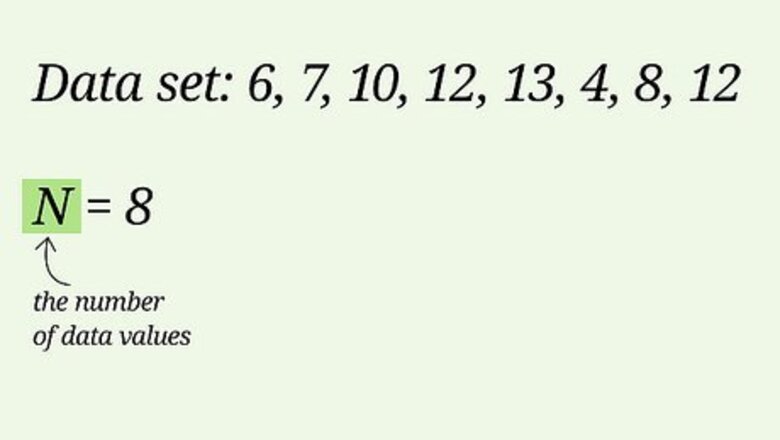
views
Calculating the Mean

Collect and count your data. For any set of data values, the mean is a measure of central value. Depending on the type of data, the mean tells you the central value of that data. To find the mean, you must first collect your data, either through an experiment of some sort or just from an assigned problem. For this example, use the assigned data set of 6, 7, 10, 12, 13, 4, 8 and 12. This set is small enough to count by hand to find that there are eight numbers in the set. In statistical work, the variable N {\displaystyle N} N or n {\displaystyle n} n is commonly used to represent the number of data values.
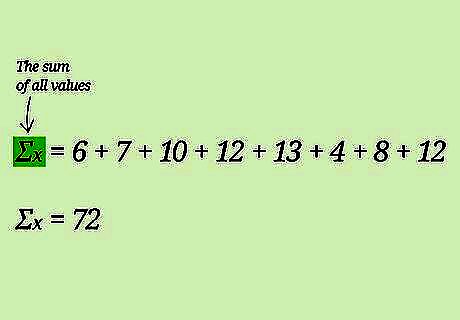
Find the sum of the data values. The first step of finding the mean is calculating the sum of all the data points. In statistical notation, each value is generally represented by the variable x {\displaystyle x} x. The sum of all values is symbolized as Σ x {\displaystyle \Sigma x} \Sigma x. The capital Greek letter sigma signifies finding the sum of the values. For this sample data set, the calculation is: Σ x = 6 + 7 + 10 + 12 + 13 + 4 + 8 + 12 = 72 {\displaystyle \Sigma x=6+7+10+12+13+4+8+12=72} \Sigma x=6+7+10+12+13+4+8+12=72

Divide to find the mean. Finally, divide the sum by the number of values. The Greek letter mu, μ {\displaystyle \mu } \mu , is commonly used to represent the mean. Therefore, the calculation of the mean is: μ = Σ x N = 72 8 = 9 {\displaystyle \mu ={\frac {\Sigma x}{N}}={\frac {72}{8}}=9} \mu ={\frac {\Sigma x}{N}}={\frac {72}{8}}=9
Finding the Mean Deviation

Set up a table. To keep your data in good order and to help with the calculations, it is helpful to create a three-column table. Label the first column x {\displaystyle x} x. Label the second column x − μ {\displaystyle x-\mu } x-\mu . Label the third column | x − μ | {\displaystyle |x-\mu |} |x-\mu |. Fill the first column with the data points for your calculation.
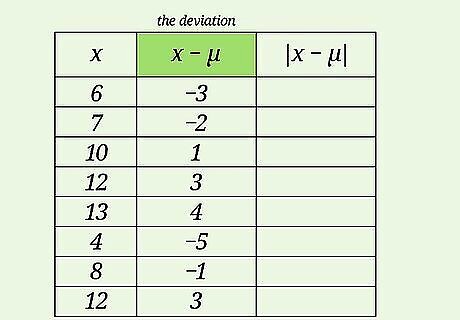
Calculate the deviation of each data point. In the second column, which you have labeled x − μ {\displaystyle x-\mu } x-\mu , you will report the deviation or difference between each data point and the mean of the set. Find this value simply by subtracting the mean from each data value. For the sample data set, these deviations will be: 6 − 9 = − 3 {\displaystyle 6-9=-3} 6-9=-3 7 − 9 = − 2 {\displaystyle 7-9=-2} 7-9=-2 10 − 9 = 1 {\displaystyle 10-9=1} 10-9=1 12 − 9 = 3 {\displaystyle 12-9=3} 12-9=3 13 − 9 = 4 {\displaystyle 13-9=4} 13-9=4 4 − 9 = − 5 {\displaystyle 4-9=-5} 4-9=-5 8 − 9 = − 1 {\displaystyle 8-9=-1} 8-9=-1 12 − 9 = 3 {\displaystyle 12-9=3} 12-9=3 To check the validity of your calculations, the sum of the values in this deviation column should be 0. If you add them up and get something other than 0, then either your mean is incorrect or you made an error in calculating one or more of the deviations. Go back and check your work.
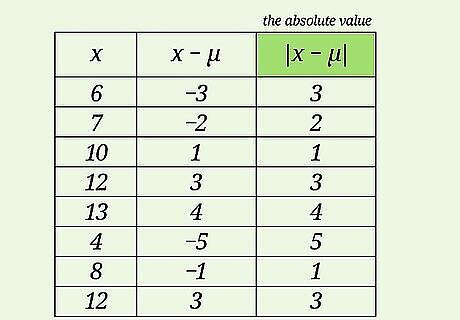
Find the absolute value of each deviation. When you calculate the deviation of each data point from the mean, you are concerned only with the size of the difference, and not whether the difference is positive or negative. What you really need, then, in mathematical terminology, is the absolute value of the difference. Absolute value is designated symbolically with the vertical bars | |. Absolute value is a mathematical tool used to measure distance or size, regardless of direction. To find absolute value, just drop the negative sign from each number in the second column. Thus, fill the third column with the absolute values as follows: x . . . . . ( x − μ ) . . . . . | ( x − μ ) | {\displaystyle x.....(x-\mu ).....|(x-\mu )|} x.....(x-\mu ).....|(x-\mu )| 6.......... − 3..........3 {\displaystyle 6..........-3..........3} 6..........-3..........3 7.......... − 2..........2 {\displaystyle 7..........-2..........2} 7..........-2..........2 10..........1..........1 {\displaystyle 10..........1..........1} 10..........1..........1 12..........3..........3 {\displaystyle 12..........3..........3} 12..........3..........3 13..........4..........4 {\displaystyle 13..........4..........4} 13..........4..........4 4.......... − 5..........5 {\displaystyle 4..........-5..........5} 4..........-5..........5 8.......... − 1..........1 {\displaystyle 8..........-1..........1} 8..........-1..........1 12..........3..........3 {\displaystyle 12..........3..........3} 12..........3..........3
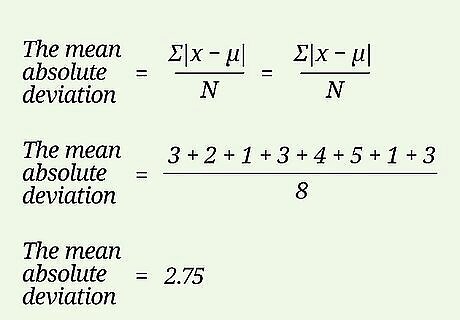
Calculate the mean of the absolute deviations. After completing your three-column table, find the mean of the absolute values in the third column. As you did to find the mean of the original data points, add the deviations together and divide the sum by the number of values. For this data set, this final calculation will be: 3 + 2 + 1 + 3 + 4 + 5 + 1 + 3 8 = 22 8 = 2.75 {\displaystyle {\frac {3+2+1+3+4+5+1+3}{8}}={\frac {22}{8}}=2.75} {\frac {3+2+1+3+4+5+1+3}{8}}={\frac {22}{8}}=2.75

Interpret the result. The value of the mean deviation about the mean is a measure of how closely grouped your data values are. It answers the question, “How close to the mean, on average, are the data values?” For example, with this data set, you can say that the mean is 9 and the average distance from that mean is 2.75. Note that some numbers are closer than 2.75 and some are farther. But that is the average distance.


















Comments
0 comment